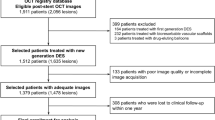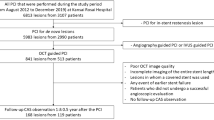Abstract
Background
Incomplete stent expansion and inadequate apposition predispose to stent thrombosis following percutaneous coronary intervention. Recent studies have shown that increasing the duration of balloon inflation during stent employment was beneficial. Thus, the balloon inflation time required for optimal stent expansion and apposition in patients receiving second-generation drug-eluting stents (DES) were determined using optical coherence tomography (OCT).
Patients and methods
Between April 2014 and March 2015, 38 patients (28 men, 10 women; mean age 60.5 ± 11.4 years) with stable angina pectoris due to single significant de novo coronary artery stenosis were prospectively enrolled. All patients were administered aspirin and clopidogrel and received weight-adjusted intravenous unfractionated heparin. Images of basal lesions were obtained using the C7XR LightLab Dragonfly OCT catheter.
Results
Expansion and apposition parameters improved with increasing duration of balloon inflation (30 s or 60 s) with nominal pressure (12 atm). Mean lesion length was 19.8 ± 7.6 mm. Mean stent diameter and length were 2.8 ± 0.36 mm and 24.9 ± 7.6 mm, respectively.
Conclusion
With deployment of a stent at nominal pressure with conventional duration, inadequate stent expansion and malapposition frequently occurred as detected by OCT; however, a balloon inflation duration of 60 s markedly improved stent expansion and apposition parameters without significant complications.
Zusammenfassung
Hintergrund
Die unvollständige Stentexpansion und unzureichende Apposition prädisponieren für eine Stentthrombose nach perkutaner Koronarintervention. In aktuellen Studien wirkte sich eine Verlängerung der Balloninsufflationszeit während der Stentimplantation positiv aus. Daher wurde mithilfe der optischen Kohärenztomographie (OCT) die Balloninsufflationszeit bestimmt, die für eine optimale Stentexpansion und -apposition bei Implantation von medikamentenfreisetzenden Stents („drug-eluting stents“ [DES]) der zweiten Generation erforderlich ist.
Patienten und Methoden
Von April 2014 bis März 2015 wurden 38 Patienten (28 Männer, 10 Frauen; Durchschnittsalter 60,5 ± 11,4 Jahre) mit stabiler Angina pectoris aufgrund einer einzelnen signifikanten De-novo-Koronarstenose prospektiv eingeschlossen. Alle Patienten erhielten Acetylsalicylsäure, Clopidogrel und gewichtsadaptiert unfraktioniertes Heparin intravenös. Bilder der grundlegenden Läsionen wurden mit dem C7XR-LightLab-Dragonfly-OCT-Katheter angefertigt.
Ergebnisse
Die Expansions- und Appositionsparameter verbesserten sich mit zunehmender Dauer der Balloninsufflation (30 s oder 60 s) bei Nenndruck (12 atm). Die mittlere Läsionslänge betrug 19,8 ± 7,6 mm. Der mittlere Stentdurchmesser lag bei 2,8 ± 0,36 mm, die mittlere Länge bei 24,9 ± 7,6 mm.
Schlussfolgerung
Wie die OCT-Aufnahmen zeigten, kam es häufig zu einer unzureichenden Stentexpansion und Stentmalapposition, wenn ein Stent bei Nenndruck mit gängiger Dauer implantiert wurde. Eine Balloninsufflationszeit von 60 s verbesserte dagegen deutlich die Stentexpansions- und Stentappositionsparameter ohne erhebliche Komplikationen.


Similar content being viewed by others
References
Kastrati A, Schömig A, Elezi S, Schühlen H, Dirschinger J, Hadamitzky M, Wehinger A, Hausleiter J, Walter H, Neumann F‑J (1997) Predictive factors of restenosis after coronary stent placement. J Am Coll Cardiol 30:1428–1436
Kasaoka S, Tobis JM, Akiyama T, Reimers B, Di Mario C, Wong ND, Colombo A (1998) Angiographic and intravascular ultrasound predictors of in-stent restenosis. J Am Coll Cardiol 32:1630–1635
Cook JR, Mhatre A, Wang FW, Uretsky BF (2014) Prolonged high-pressure is required for optimal stent deployment as assessed by optical coherence tomography. Catheter Cardiovasc Interv 83:521–527
Blackman DJ, Porto I, Shirodaria C, Channon KM, Banning AP (2004) Usefulness of high-pressure post-dilatation to optimize deployment of drug-eluting stents for the treatment of diffuse in-stent coronary restenosis. Am J Cardiol 94:922–925
Cheneau E, Satler LF, Escolar E, Suddath WO, Kent KM, Weissman NJ, Waksman R, Pichard AD (2005) Underexpansion of sirolimus-eluting stents: Incidence and relationship to delivery pressure. Catheter Cardiovasc Interv 65:222–226
Javaid A, Chu WW, Cheneau E, Clavijo LC, Satler LF, Kent KM, Weissman NJ, Pichard AD, Waksman R (2006) Comparison of paclitaxel-eluting stent and sirolimus-eluting stent expansion at incremental delivery pressures. Cardiovasc Revasc Med 7:208–211
Gonzalo N, Serruys PW, Okamura T, Shen ZJ, Onuma Y, Garcia-Garcia HM, Sarno G, Schultz C, van Geuns RJ, Ligthart J (2009) Optical coherence tomography assessment of the acute effects of stent implantation on the vessel wall: a systematic quantitative approach. Heart 95:1913–1919
Iwamoto Y, Okamoto M, Hashimoto M, Fukuda Y, Iwamoto A, Iwasaki T, Kinoshita H, Kihara Y (2012) Better stent expansion by two-time inflation of stent balloon and its responsible mechanism. J Cardiol 59:160–166
Ann SH, Chung JW, De Jin C, Lee JH, Kim JM, Garg S, Shın ES (2014) Better Inflation Time of Stent Balloon for Second-Generation Drug-Eluting Stent Expansion and Apposition: An Optical Coherence Tomography Study. J Interv Cardiol 27:171–176
Trindade IS, Sarmento-Leite R, de Freitas SM, Gottschall C (2008) Determination of the minimum inflation time necessary for total stent expansion and apposition: an in vitro study. J Invasive Cardiol 20:396–398
Hovasse T, Mylotte D, Garot P, Salvatella N, Morice MC, Chevalier B, Pichard A, Lefèvre T (2013) Duration of balloon inflation for optimal stent deployment: Five Seconds Is Not Enough. Catheter Cardiovasc Interv 81:446–453
Fujii K, Mintz GS, Kobayashi Y, Carlier SG, Takebayashi H, Yasuda T, Moussa I, Dangas G, Mehran R, Lansky AJ (2004) Contribution of stent underexpansion to recurrence after sirolimus-eluting stent implantation for in-stent restenosis. Circulation 109:1085–1088
Sonoda S, Morino Y, Ako J, Terashima M, Hassan AH, Bonneau HN, Leon MB, Moses JW, Yock PG, Honda Y (2004) Impact of final stent dimensions on long-term results following sirolimus-eluting stent implantation. J Am Coll Cardiol 43:1959–1963
Russo RJ, Silva PD, Teirstein PS, Attubato MJ, Davidson CJ, DeFranco AC, Fitzgerald PJ, Goldberg SL, Hermiller JB, Leon MB. A randomized controlled trial of angiography versus intravascular ultrasound-directed bare-metal coronary stent placement (the AVID Trial). Circ Cardiovasc Interv (2009) CIRCINTERVENTIONS. 108.778647
Gil RJ, Pawłowski T, Dudek D, Horszczaruk G, Żmudka K, Lesiak M, Witkowski A, Ochała A, Kubica J, Trial IoDSvOA. (2007) Comparison of angiographically guided direct stenting technique with direct stenting and optimal balloon angioplasty guided with intravascular ultrasound. The multicenter, randomized trial results. Am Heart J 154:669–675
Kawasaki T, Koga H, Serikawa T, Orita Y, Ikeda S, Mito T, Gotou Y, Shintani Y, Tanaka A, Tanaka H (2009) Impact of a prolonged delivery inflation time for optimal drug-eluting stent expansion. Catheter Cardiovasc Interv 73:205–211
Asano T, Kobayashi Y, Fukushima K, Iwata Y, Kitahara H, Ishio N, Nakayama T, Kuroda N, Komuro I (2009) Effect of balloon inflation time on expansion of sirolimus-eluting stent. Heart Vessels 24:335–339
Regar E, Ligthart J, Bruining N, van Soest G (2011) The diagnostic value of intracoronary optical coherence tomography. Herz 36(5):417–429 (Aug)
Author information
Authors and Affiliations
Corresponding author
Ethics declarations
Conflict of interest
O. Tasar, A.K. Karabay, C.Y. Karabay, S. Kalkan, G. Cinier, I.H. Tanboga, A.I. Izgi and C. Kırma declare that they have no competing interests.
This article does not contain any studies with human participants or animals performed by any of the authors.
Rights and permissions
About this article
Cite this article
Tasar, O., Karabay, A.K., Karabay, C.Y. et al. Optical coherence tomography-verified longer balloon inflation time may provide better stent apposition and optimal index parameters. Herz 45, 369–374 (2020). https://doi.org/10.1007/s00059-018-4738-7
Received:
Revised:
Accepted:
Published:
Issue Date:
DOI: https://doi.org/10.1007/s00059-018-4738-7
Keywords
- Percutaneous coronary interventions
- Coronary artery stenosis
- Myocardial ischemia
- Thrombosis
- Myocardial infarction




